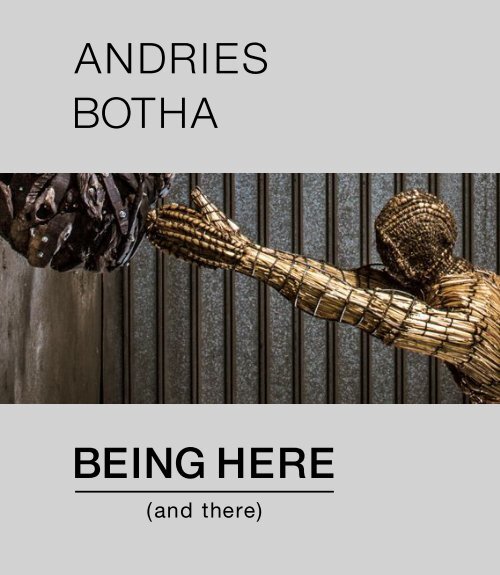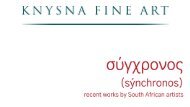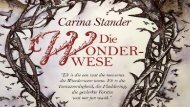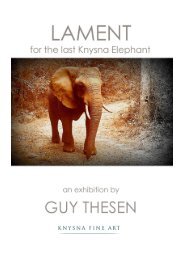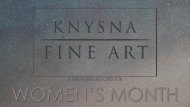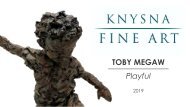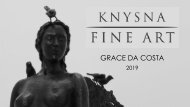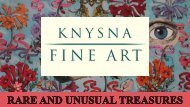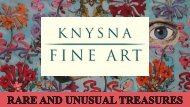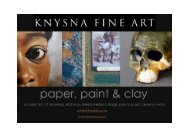Andries Botha Catalogue
Create successful ePaper yourself
Turn your PDF publications into a flip-book with our unique Google optimized e-Paper software.
ANDRIES<br />
BOTHA<br />
BEING HERE<br />
(and there)
AN EXHIBITION PRESENTED BY
“Our song is violence, and we sing it beautifully<br />
- I said that? I can’t believe I said that shit.”<br />
- <strong>Andries</strong> <strong>Botha</strong>
CONTENTS<br />
1<br />
2<br />
3<br />
4<br />
5<br />
6<br />
7<br />
8<br />
9<br />
10<br />
11<br />
12<br />
13<br />
Introduction by Trent Read ......................................................................... 1<br />
Being Here (and there) by <strong>Andries</strong> <strong>Botha</strong> ..................................................... 2<br />
Genesis, Genesis, Jesus… ................................................................................ 4<br />
Genesis, Genesis, Jesus… [Detail] ................................................................ 6<br />
Embarkation ..................................................................................................... 8<br />
Embarkation [Detail] ................................................................................... 10<br />
Loxodanta Africana ........................................................................................... 12<br />
Loxodanta Africana [Detail] .......................................................................... 14<br />
Afrikaner Circa 2014 .................................................................................. 16<br />
Afrikaner Circa 2014 [Detail] ....................................................................... 18<br />
Just Being by Hazel Friedman .................................................................... 20<br />
Cirriculum Vitae of <strong>Andries</strong> <strong>Botha</strong> ............................................................... 24<br />
Special Thanks.......................................................................................... 28
INTRODUCTION<br />
BY TRENT READ<br />
Sculpture in South Africa has enjoyed somewhat of a renaissance in the last decade or so, with<br />
arguably the finest and most thought provoking art made in the country being three-dimensional.<br />
This certainly was not the case when I entered the field some forty years ago. The sculptors, on<br />
the whole, were a fairly pedestrian bunch making saccharine bronzes of wildlife subjects, large<br />
monuments to apartheid heroes or, amongst the more up to date, fairly sterile abstracted works<br />
that had a “modern” air to them. We were in the midst of the cultural boycott and although works<br />
by Elisabeth Frink, Lyn Chadwick and a few others were occasionally seen, sculpture was safe,<br />
boring and above all European.<br />
In my opinion two artists were largely responsible for the massive changes that occurred in the<br />
early Eighties long before the ending of apartheid and our reacceptance as part of a larger art<br />
community. The sculptors were Jane Alexander and <strong>Andries</strong> <strong>Botha</strong> and I well remember how<br />
their work made everything else look somehow small and not very interesting. Jane was a<br />
little younger than <strong>Andries</strong> and her output was tiny but <strong>Andries</strong>’ work was inescapable. He made<br />
pieces that were radical in their mix of media and breath taking in their sly subversity (in a<br />
society that was walled in by security laws and where censorship (and worse) were<br />
commonplace). Above all he made works that were African in their choice of subject and use of<br />
media and this was his greatest gift to this country and a huge inspiration to two generations of<br />
students.<br />
I believe this also led to a change of focus by collectors, both private and institutional. Like the<br />
Dutch forefathers of many of them, South Africans tended to collect modest sized paintings<br />
and drawings more appropriate in scale to an Amsterdam townhouse. This started to change in<br />
the early nineties when mixed media sculpture and installations began cautiously to be bought<br />
by a few of the more prescient buyers. This is wholly suited to our landscape and our complex<br />
shared culture.<br />
I think that this show amply illustrates my contention that <strong>Andries</strong> <strong>Botha</strong> is our preeminent<br />
sculptor and I am proud to have been able to facilitate the exhibition at this lovely space at<br />
Grande Provence.<br />
The exhibition is extraordinary in that it is showing a major work from each decade including<br />
one that has only been seen at documenta in Kassel in the 90’s and the works have never been<br />
shown together anywhere.<br />
1
BEING HERE (and there)<br />
BY ANDRIES BOTHA<br />
When I was young and wondering what it would be like not to be what everyone wanted me to be,<br />
unpredictable thoughts became ideas, and then my life. The idea that took shape instantly, in<br />
immediate and unpredictable circumstances, was that I imagined myself as a sculptor, when I did<br />
not even know what sculpture was. I saw a picture of Michelangelo’s slaves lying on my friends<br />
coffee table and asked “...what is this?”. “Sculpture, my mother loves this stuff“, he said. “I am<br />
going to do that “, I said. So that’s the story of my art career; an illogical necessity that keeps<br />
upsetting everyone, but me. Inbetween the what, the how and the why not, hovers a much longer<br />
story, eventually leading me to 2016 and this exhibition with Trent Read.<br />
I was in the familiar space of changing my mind, retreating from the public eye into my own private<br />
space, when Trent showed up at my Durban studio. He saw some of my older work, which I was in<br />
the process of cleaning and restoring, along with some new drawings and offered me a show. The<br />
journey from the private into the public has always been scary. Exposing the intimate as a form of<br />
public intent, subject to market force and critical commentary can become a perilous dance.<br />
I confess I have always been wary of this, shying away from normal commercial gallery leylines.<br />
Most of my major works were made as part of my own meditation on self within the frightening or<br />
challenging South African space. I exhibited (mostly abroad) as part of larger group shows, then<br />
crated and stored the (hidden again) work. Still not sure what all this means but I sort of understand<br />
my life of creativity as a embodiment of this ambivalence or uncertainty. Making sculpture and then<br />
not sure how or where to show it, or if I should at all...,creating the work and making more...<br />
Now I have all this work which speaks of 40 years of sculpture making. And some other stuff, all<br />
neatly stored away. Strange when you look at your life in this way and realise it’s peculiarity...<br />
The works do speak for themselves and have their narratives secretly woven into them. Speaking<br />
or analysing your intent flattens the work and destroys the subtlety and mystery of everything. This<br />
is the viewers work. Upon reflection, I return to similar concerns and merely express them<br />
differently. I soon learnt that material and mode of construction was as important as the ideas that<br />
were being explored. I try to locate the human(ity) within the visceral, social and cultural spectacle.<br />
The complex South African context unashamedly frames the universal human experience. Mine as<br />
well. It is difficult to imagine expressing myself in any other way.<br />
I am going to show 4 major works that frame a history of art making, a sort of love affair in a time<br />
line, if you wish. In addition there will be about 10 large digital prints and 3 multi media Marquette’s,<br />
or three dimensional drawings.<br />
I am pleased to be back in the private contemplative space. Yes, I am hesitant to be journeying into<br />
the public again, but happy I am doing it with Trent. So I come into another circle/cycle.<br />
Interesting how life is...<br />
2
3
4<br />
Genesis, Genesis, Jesus…<br />
leadwood, thatching grass, metal<br />
L 270 x W 123 x H 200 cm<br />
1989
5
6<br />
Genesis, Genesis, Jesus…<br />
[Detail]
7
8
Embarkation<br />
polypropylene rope, wattle wood, galvanized sheeting,<br />
plastic sheeting, canvas, stainless steel mesh, mild steel,<br />
found objects, resin, lead<br />
L 700 x B 350 x H 180 cm<br />
1995<br />
9
10<br />
Embarkation [Detail]
11
12
Loxodanta Africana<br />
polyester resin<br />
L 150 x W 380 x H 105 cm<br />
2011<br />
13
Loxodanta Africana [Detail]<br />
14
15
16
Afrikaner Circa 2014<br />
acrylic on canvas, landscape in the manner of<br />
Pierneef; material one; mild steel; 3D printed<br />
figure in supawood; artificial landscape turf<br />
Variable dimensions<br />
2014<br />
17
18<br />
Afrikaner Circa 2014 [Detail]
19
JUST BEING<br />
BY HAZEL FRIEDMAN<br />
‘The only way to deal with an unfree world is to become so absolutely free that your very<br />
existence is an act of rebellion’. - Albert Camus ‘The Stranger’ (1942)<br />
There’s a scene in the movie ‘Being There’ where USA President ‘Bobby’ asks Chauncey<br />
Gardner (Chance the Gardener) his prognosis for economic growth. ‘As long as the roots are not severed,<br />
all will be well in the garden’, is the reply by a presidential candidate whose mind has been engineered to<br />
respond in simplistic homilies snugly blanketed in bucolic adjectives.<br />
You might ask what a movie about a simple, sheltered gardener who becomes an insider in Washington<br />
politics has to do with an artist whose profundity of vision represents the very antithesis of shallow<br />
sound-bites and abbreviated attention-spans?<br />
Yet ‘Being Here (and there)’, the title of <strong>Andries</strong> <strong>Botha</strong>’s first exhibition on South African soil in many years<br />
does remind me of the universal wisdom of simplicity, of being in the moment and of revisiting roots that<br />
might have been dug up, replanted, rerouted but never fully severed. ‘Being There (or there)’ is about the<br />
parody and deconstruction of engineered personal and public narratives.<br />
<strong>Botha</strong>’s work is paradoxically ‘rooted’ in a sense of dislocation and non-belonging. In his artists’<br />
statement for ‘Being Here (or there)’ he describes producing most of his major works ‘as part of my own<br />
meditation on self within the frightening, or challenging South African space’. He also speaks openly about<br />
the ambivalence he feels between embracing the international success of his career and an essentially<br />
solitary creative quest: withdrawal from the public pantheon in order to nurture ‘an internal space’. Both<br />
activist and archivist, <strong>Botha</strong> has produced sculptural installations that stand tall among the greatest<br />
contemporary South African public art produced during and after apartheid. This public art has evolved<br />
from a profoundly personal, ongoing struggle that has served as a recurring refrain in his life and art.<br />
Although located in the specifics of time and place, it transcends both states, becoming ‘a part of’ yet<br />
remaining ‘apart from’.<br />
There is a harmonius ebb and flow to the artist’s conversation. Eloquent and elegant, his sentences are<br />
layered, intricately structured and interwoven with metaphor and meaning, much like the monumental<br />
sculptural installations that mark four decades of a stellar career, replete with prestigious individual artistic<br />
awards, major public commissions, ongoing community projects and international showings; not to<br />
mention political controversy. But underpinning <strong>Botha</strong>’s prodigious oeuvre is a disarming simplicity and<br />
almost self-deprecatory humility. Despite his global success, he has remained surprisingly free of the<br />
hustle and hype that often sticks to the coattails of celebrity, like dust on velcro.<br />
For ‘Being Here (or there)’, gallerist and exhibition curator, Trent Read has selected four major installations<br />
that serve as indeces to the four decades of his extraordinary output. <strong>Botha</strong> describes his collaboration<br />
with Read as an ‘incredible synergy’. The works have never been seen together, and one of them has only<br />
ever been seen at Documenta in Kassel in the 90’s. They include ‘Genesis, Genesis Jesus’ (1989),<br />
‘Embarkation’ (1995), ‘Afrikaner Circa 2014’ and ‘Loxodonta Africana’ (2015). Also included in this seminal<br />
show are 10 large digital prints and 4 multi media drawings, mapping some of the dominant terrain<br />
traversed by <strong>Botha</strong> over the last four decades.<br />
20
Revisiting these fruits of a labour-intensive career located in the literal materiality of the South African<br />
landscape must constitute an exhilarating rediscovery for <strong>Botha</strong>. From the prism of time and distance they<br />
offer fresh insights and revelations, while re-affirming the artist’s ongoing themes. “I have always<br />
interrogated public space around presence and absence of monumentality,” he explains, ‘and how we go<br />
about rewriting an engineered narrative. “In many respects these works represent a continuum of recurring<br />
concerns, merely expressed differently”.<br />
<strong>Botha</strong> cautions against over-analysis of artistic intention. The work must speak on multiple layers, both<br />
patent and subliminal, intellectually and intuitively. The multivalent layers of his art that they speak, not only<br />
to, but also about the past four decades. They continue to resonate in a world that has become<br />
increasingly atomised, fractured and digitally arcane. It is impossible to adequately encapsulate the breadth<br />
and depth of <strong>Botha</strong>’s creative journey in a single essay. To describe his personal quest as a search for<br />
authenticity and identity through the thicket of ideological fictions goes some of the way towards attaining a<br />
neat, albeit simplistic, definition. But even though the struggles with the contradictions of his own heritage<br />
– raised as a white Afrikaans male during apartheid – form the most obvious bookends of his works. <strong>Botha</strong>’s<br />
creative trajectory is far more subtle and fluid.<br />
He recalls being shaken out of his prescribed ‘Afrikaner identity’ by the discourse of young black activists,<br />
and being awoken to the imperatives of interrogating an ‘engineered’ narrative not merely around the<br />
justifications for political disenfranchisement but about ‘the destruction of humanity itself’. Although tutored<br />
in the ‘mimicry of a Eurocentric modernity’ <strong>Botha</strong> also began to rebel against the art-from-the-west-is-best<br />
mindset, with its emphasis on a ‘fine-art’ hierarchy and gallery system. Apartheid ethnocentrism had<br />
undermined the aesthetic value of indigenous South African cultural production and artifacts. During the<br />
political upheavals of the mid 1980s, the ideological glue that had bound this form of cultural snobbery was<br />
starting to come unstuck. It was principally artists like <strong>Botha</strong>, who wholeheartedly embraced the traditional<br />
weaving techniques and materials from the midlands of KwaZulu-Natal, where he was raised, that South<br />
African traditions of craft-art, who practiced predominantly in rural areas, became legitimised – albeit<br />
belatedly - by the mainstream South African art world.<br />
Disruptive and distorted power relations between Eurocentric and African paradigms are dramatically<br />
articulated in Genesis, Genesis Jesus (1989), which can be read as much in terms of spiritual conflict as<br />
it does about the interface between material, mythology and metaphysics. A prostrate, Promethean-type<br />
form is stacked and packed from leadwood - a protected deciduous South African tree. It provides a plinth<br />
for the acrobat/dancer possessed of the grace of a Degas or Rodin sculpture. Yet this form is constructed<br />
not from the ‘classical’ materials of the European sculptor, but rather from the craft-intensive traditional<br />
Zulu grass weaving techniques. In this work brute force and beauty coalesce in a precarious pas de deux.<br />
Both material and metaphor make powerful references to bodies, land and the historical contestation<br />
thereof – a conflict that continues well into the 22nd year of post-apartheid South Africa and feeding into<br />
current debates around transformation and other combustible discourses.<br />
Executed at the cusp of a new era in South African history it is impossible to avoid a political reading of<br />
<strong>Botha</strong>’s work during the late 1980s and early- mid 1990s. But this becomes a rather glib observation in<br />
relation works like ‘Embarkation’ (1995) – one of <strong>Botha</strong>’s works that while emblematic of an era, defies neat<br />
21
categorisation. As the artist explains on his website ‘Embarkation’ is ‘a sculptural fragment‘ of a 6-piece<br />
installation entitled What is a Home. Using symbolicall ycharged materials, such as wood from ’alien’ trees,<br />
galvanised zinc and plastic sheeting – referencing the materials of informal settlements - canvas, tyres,<br />
telephone wire and found objects, the work is much more than a meshing of Western and African culture.<br />
It explores the trajectory of identity and diaspora, both in the contexts of personal memory, politics and<br />
cultural currency. Indeed, the bipolar states of local versus international have complicated the production,<br />
display and consumption of art, particularly of a democracy that, at 22 years-old, is still, relatively, the<br />
ingénue at the global art ball. ‘Embarkation’ is about the perennial outsider. The converse is also suggested<br />
through the narrow spaces between <strong>Botha</strong>’s physical forms and the physical topography they evoke; that<br />
there is often an inextricable sense of ‘belonging’ between self and land. It is a bond that has been used<br />
to justify the most violent contestations of ownership. Yet ‘Embarkation’ ultimately denotes a state of<br />
departure, arrival and transit. It also suggests that art, like self-identity and cultural identification, is always<br />
on a threshold, shifting from stasis to passage, and vice versa.<br />
‘Afrikaner Circa 2014’ is the third of the four installations that as <strong>Botha</strong> explains ‘frame a history of<br />
making, a sort of love affair in a time line’. In this work, as with the others there is an intricate interweaving<br />
of social, spiritual, cultural and historical representations. It is also in this work that one can<br />
choose to focus on <strong>Botha</strong>’s documentary and conceptual strategies that are informed as much by language<br />
and political theory as by aesthetic discourse. The date that marks the genesis of the ANC -1912 - is also<br />
the date that a new breed of cattle came to the attention of South African farmers: the Afrikaner. Although<br />
it had been around for about 2000 years and was widely used by the ‘Hottentots’ in the era of Jan Van<br />
Riebeeck, this breed, like the Volk after who it has been named, was nearly exterminated in the Boer War.<br />
The Afrikaner cattle – that ‘pure bred’, yet inbred, prized, hybridized beast that has now been located or<br />
dated as ‘circa’ - as a ‘historical’ – possibly extinct - phenomenon, identified principally by an indeterminate<br />
date of origin, much like a fossil or fragment of bone excavated from an archaeological site. Perched<br />
in the background of the installation is a framed landscape by Pierneef, appropriated by <strong>Botha</strong> to critique<br />
the fiction of South African nationalism that represented the landscape as an unpopulated paradise to be<br />
conquered and civilised by whites. In these works <strong>Botha</strong>’s parody and subversion of language is integral to<br />
the narrative of the work. The Afrikaner metaphor also alludes to masculinity, hides, skins and, of course, in<br />
traditional husbandry and African culture, to currency and wealth. It is as though the material has memory,<br />
like muscle. As such, the work is as much about the mediation of human agency in the valuation of objects<br />
within a matrix of socio-political structures as it is about the flux of histories, cultures and identities.<br />
There is however also a profoundly intimate subtext to ‘Afrikaner Circa 2014’ that relates directly to an<br />
earlier work executed in 2006 called ‘Afrikaander Circa 1600.’ As <strong>Botha</strong> himself explains of the former<br />
installation: “In many respects, it signifies the closure of a ‘tender conversation’ between myself and my<br />
father that was first articulated in ‘Afrikaander circa 1600’.” This conversation between father and son<br />
revolved around the ongoing, painful struggle <strong>Botha</strong> has expressed about the Dutch-Afrikaner identity - the<br />
distorted colonial embodiment of masculinity and patriarchy - imposed upon him and generations of South<br />
Africans. Both installations are comprised of materials and archetypal imagery associated with domesticity,<br />
agriculture, anthropology and archaeology. Each exudes a sense of containment – the focus of the earlier<br />
work is literally a container - while in ‘Afrikaner circa 2014’ the Ram is caged in a coop whose diameters<br />
conform to the classical measurements used to cordon off archaeological sites.<br />
The excavation metaphor is redolent with association, alluding to digging up or unearthing hidden<br />
histories and exposing which ‘lies’ are buried beneath the surface. It speaks of fracture, erasure and<br />
22
historical trauma that are as much of the individual psyche as they are the consequence of collective,<br />
cultural misrepresentations.<br />
At the risk of providing an overly manicured trajectory of <strong>Botha</strong>’s 40-year oeuvre it is evident that one of his<br />
increasingly visible and volatile concerns revolve around using art as a means of challenging and exploring<br />
alternate models of survival in shifting, interdependent environments.<br />
“I’ve been creating metaphors that frame human experience in the landscape, so it was inevitable that my<br />
art would embrace the ecological meta-narrative that informs and will determine the survival of our planet”,<br />
he explains of his many collaborative sculptures and themes revolving around conservation. Fittingly, the<br />
fourth major work in ‘Being Here (or there)’ is ‘Loxodonta Africana’ (2015). Translated from Latin as<br />
Savannah Elephant, it represents an archetypal symbol of power; its Zulu name is Ndlovu, meaning ‘chief’.<br />
It also symbolises collective unconscious and the unspoken conversation between humanity and the<br />
natural ewwecology. This symbol has also been crudely appropriated by power-mongers and king-makers<br />
to engineer their own narratives of political hegemony. In <strong>Botha</strong>’s lexicon it patently and poignantly references<br />
Renaissance painter Andrea Mantegna’s depiction of the martyrdom of Saint Sebastian - the 15th century<br />
saint, known as the ‘protector of plagues. His death unleashed a devastating epidemic that almost<br />
decimated Europe. <strong>Botha</strong>’s analogy is chilling. The wounded elephant is emblematic of an endangered<br />
planet’ – a state of being that, as <strong>Botha</strong>’s friend and mentor, the late Ian Player warned, was entering into<br />
the collective sub-conscious.<br />
‘We are at the point in our history where the very best of our reason has placed us at the greatest risk of<br />
destroying ourselves and our habitat’. He warns: ‘This is the time to explore different modalities that<br />
mediate the dance between head and heart.’<br />
The real powers that shape the conditions under which we all act these days flow in global space. They<br />
determine the commercial traffic between conservation and culture; not to mention their co-option.<br />
At the time of conceptualizing this essay, South Africa again encapsulates the contradictions that beset<br />
the planet in the terrain of ecology, education, economics, heritage, ideology and psychology. Bodies, land<br />
and power still remain contested terrains of transformation. Small men with oversized egos preen on public<br />
podiums, intent on re-engineering new artifacts and fictions of power; the roots thereof are often banal but<br />
their implementation brutal and narcissistic. We have attended the self-congratulatory conferences; we<br />
have read the noble legislation, gaping at the abyss between intention and implementation. And we have<br />
watched the mind-numbing reruns of the miniseries with their revolving door of characters. Like the people<br />
populating the inchoate world of Chauncey Gardner in ‘Being There’, the script and sound-bites, like the<br />
collective attention-span, simply get shallower.<br />
23
CURRICULUM VITAE<br />
OF ANDRIES BOTHA<br />
Exhibitions<br />
2015<br />
2014<br />
2012<br />
2011<br />
2010<br />
2009<br />
2008<br />
Donated the permanent exhibition of a life size elephant sculpture to the<br />
Shobiyana Secondary School as part of a creative project: “Skills of Our<br />
Children”, Acornhoek, Mpumalanga, South Africa.<br />
Participated in Robert Rauschenberg Foundation Residency, Florida, USA.<br />
“100”, Centenary Exhibition, Everard Read Gallery, South Africa,<br />
14 November 2013-31.<br />
January 2014. Artwork: “Afrikaner circa 2014”, Acrylic on canvas, landscap in<br />
the manner of Pierneef; Material One; mild steel; 3D printed figure in<br />
Supawood; artificial landscape turf.<br />
Museum Beelden aan Zee, Den Haag, Netherlands, “The Rainbow Nation”, from<br />
29 May to 9 September 2012 on the Lange Voorhout and from 8 June to<br />
30 September 2012 in Beelden aan Zee Museum.<br />
Circa on Jellicoe, Rosebank, Johannesburg, South Africa, one-man exhibition,<br />
“(IN)SOMNIUM)”.<br />
Group Exhibition: “The Horse”, Everard Read Gallery, Johannesburg “2011<br />
Incheon Women Artists’ Biennale” – South Korea, Amazwi Abesi<br />
fazane project.<br />
Woordfees Artist, One man exhibition, Stellenbosch, South Africa.<br />
North American tour of Nomkhubulwane (elephant sculpture) including Chicago,<br />
Fayetteville, Bozeman, El Paso, Detroit – USA and Juarez and<br />
Cuernavaca in Mexico.<br />
La Papalote Museum, Mexico City, Mexico.<br />
Wild9 – 9th World Wilderness Congress, Merida, Mexico.<br />
Animal-Anima, Provence, France.<br />
South Gallery, Cape Town, South Africa.<br />
KZNSA Gallery, Durban South Africa.<br />
Strydom Gallery, George, South Africa.<br />
Beauty and Pleasure, Stenersen Museum, Oslo, Norway.<br />
Faculty Exhibition, KZNSA Gallery, Durban, South Africa.<br />
Workshop/Exhibition, Samata Lok Santhan, Gwalior, India.<br />
Travesia, Las Palmas de Gran Canaria.<br />
l’Homme est un Mystère #3, St. Brieuc, Côtes d’Armor, France.<br />
24
2007/9<br />
2007<br />
2006<br />
2005<br />
2004<br />
2003<br />
2002<br />
2001<br />
2000<br />
1999<br />
You can buy my heart and my soul, Royal Museum for Central Africa, Tervuren,<br />
Belgium, October 2007 to June 2009.<br />
You can buy my heart and my soul, Antwerp, Belgium.<br />
2006 Beaufort, Sculpture Triennale, De Panne and Ostend, Belgium<br />
Amazwi Abesifazane, William Benton Gallery, University of Connecticut, USA<br />
Africa Remix, Museum Kunst Palast, Düsseldorf, Germany<br />
Amazwi Abesifazane, Betty Rymer Gallery, School of the Art<br />
Institute of Chicago, Chicago, Illinois, USA<br />
Amazwi Abesifazane, Culturgest, Lisbon, Portugal<br />
Attese: Biennale of Ceramics in Contemporary Art, Albisola, Italy<br />
Amazwi Abesifazane, Africa Studie Sentrum, Leiden, The Netherlands<br />
Amazwi Abesifazane, Imagine IC, Amsterdam, The Netherlands<br />
Vidarte 2002, Mexico City, Mexico<br />
Global Priorities, New York, USA<br />
Outpost II, US Art Gallery, Stellenbosch, South Africa<br />
Amazwi Abesifazane, Prince Claus Fund, The Hague, The Netherlands,<br />
Freehouse Project, Rotterdam, Netherlands<br />
Nature, Utopia and Realities: Orsorio, Grand Canarias<br />
Memorias: Santander, Spain<br />
Amazwi Abesifazane, World Conference Against Racism, South Africa<br />
Amazwi Abesifazane, Durban Art Gallery, South Africa<br />
Area 2000: Reykjavik Art Museum, Iceland<br />
L’Afrique a Jour: Lille, France<br />
Bonnefanten Museum, Maastricht, Holland<br />
Dakart 2000 Biennale, Senegal, Africa<br />
Amazwi Abesifazane – Voices of Women, African Art Center, South Africa<br />
Galerie Paul <strong>Andries</strong>se, Amsterdam<br />
25
1998<br />
1997<br />
1996<br />
1995<br />
1994<br />
1993<br />
Kasselkunstverrein: Kassel, Germany<br />
Kulturtogbet Solvberget,Stavanger, Norway<br />
Four Seasons – National Architectural Institute, Rotterdam<br />
Johannesburg Biennale, South Africa<br />
Samtidskunst: Fra Sor Afrika, Oslo, Norway<br />
The Other Journey: Africa and the Diaspora, Kunsthalle Krems, Vienna<br />
Containers Across the Ocean, Copenhagen<br />
Cris Fertiles Unesco, Abidjan<br />
Cris Fertiles Unesco, Cotonou<br />
Transitions: Bath Festival – United Kingdom<br />
South African Contemporary Art, Paris, France<br />
Southern Cross – Stedelijke Museum, Amsterdam, Netherlands<br />
Venice Biennale, Italy<br />
Honours<br />
2003/4<br />
2000<br />
1998<br />
1994<br />
1992<br />
Consultant to the Department of Arts of Culture, Nkosi Luthuli Memorial,<br />
Kwa-Dukuza.<br />
Playground and Toys, United Nations, New York<br />
One of 12 International artists invited by Holland Foundation to work on Ujama iv<br />
project in Maputo, Mozambique<br />
Civitella Raneiri Fellowship, Italy<br />
U.S. Information Service Fellowship – University of Indiana, USA National Vita<br />
Art Award, South Africa<br />
Public Commissions<br />
2015<br />
2013/16<br />
2011<br />
Completed Three (Four) elephant sculptural installation, City of Durban,<br />
KwaZulu-Natal, South Africa.<br />
State Commission for six 2m tall bronze figures.<br />
Sculptural installation of Rev John Dube for Dube Tradeport in Durban,<br />
South Africa<br />
26
2009<br />
2008<br />
2006<br />
2004/6<br />
2004/9<br />
2003<br />
2001<br />
2000<br />
1999<br />
1997<br />
1996<br />
1993<br />
1992<br />
Started the halted Three Elephant sculptural installation, City of Durban,<br />
KwaZulu-Natal, South Africa<br />
King Shaka Sculptural Installation, King Shaka Airport, Durban,<br />
KwaZulu-Natal, South Africa.<br />
“Lux Themba”, Family Memorial, Amsterdam, Netherlands<br />
Award design and manufacture: 27th Durban International Film Festival.<br />
Ohlange Memorial Park – ANC Memorial, Durban, KwaZulu-Natal,<br />
South Africa – 5 larger-than-life bronze figures.<br />
Gandhi Foundation Awards.<br />
Shembe Memorial, Durban, KwaZulu-Natal, South Africa.<br />
Sculpture Commission, Vodacom, Cape Town, South Africa.<br />
Rijksakedemie Voor Volkenkunde, Leiden, Holland.<br />
Sculpture Commission, M.T.N., Johannesburg, South Africa.<br />
Sculpture Commission, Hilton Hotel, Durban, South Africa.<br />
Sculpture Commission, Durban Girl’s College, South Africa.<br />
Sculpture Commission, Standard Bank, Johannesburg, South Africa.<br />
Sculpture Commission, Johannesburg Art Gallery, South Africa.<br />
Teaching Experience<br />
1982 -<br />
2014<br />
Senior Lecturer, Sculpture, Durban University of Technology, Durban,<br />
South Africa.<br />
27
SPECIAL THANKS<br />
We wish to acknowledge the following individuals’ contributions to this catalogue:<br />
Karla Benade,<br />
Zandré October,<br />
Jessica Botness,<br />
Janine Zagel,<br />
Theresa Kaati,<br />
Philip Heijnen,<br />
Wentzel Combrinck.<br />
Photography by Sean Laurenz.<br />
28
gallery@grandeprovence.co.za<br />
www.finearts.co.za<br />
Main Road, Franschhoek<br />
PO Box 102, Franschhoek 7690<br />
Western Cape, South Africa<br />
T +27 (0)21 876 8630


